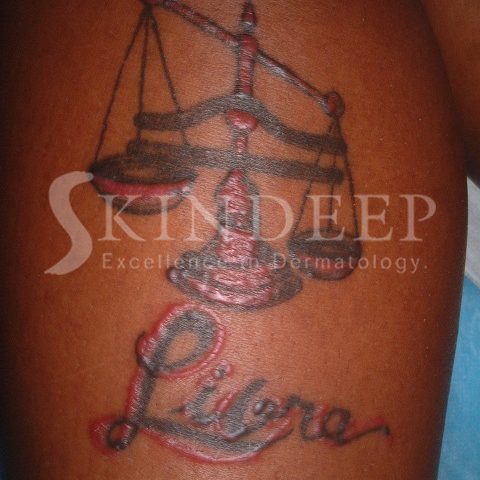The decision to acquire a tattoo is being made more frequently in our modern society. The reasons include honouring loved ones, beauty and style statements, to cover scars/blemishes or even to mark a significant life event. Of course there are many other reasons too numerous to mention.

In most cases the post tattoo experience is incident free. For some individuals however, allergic reactions to particular pigments can occur. These reactions may take days, weeks or sometimes years to develop and can vary from mild to severe. It is important to know the possible complications of any procedure before having it done.
When the ink is injected into the dermis it becomes encapsulated in fibrous tissue. The components in ink are complex, varied and continuously evolving without strict regulations to control inorganic and organic components. Various metal salts are usually responsible for reactions. Zirconium, beryllium, mercury (red), chromium (green), Cobalt (blue) and cadmium (yellow) are the main metal-based pigments used in tattooing.
Temporary tattoos with Henna are usually safe but if mixed with Paraphenylenediamine (PPD), a chemical notorious for black hair dye allergies, then contact dermatitis can occur.
TYPES OF REACTIONS
An acute inflammatory eruption occurs as a result of the piercing of the skin initially. There may redness initially followed by swelling which may last for two to three weeks before resolving. These changes are expected and only require topical antibiotic creams.
The two most common hypersensitivity reactions to tattoo pigments are allergic contact dermatitis and photoallergic dermatitis. In the latter the sun activates the skin reaction to the ink. These reactions manifest themselves as redness and swelling with a scaling or flaking surface. This can go on for months until the body breaks down the pigment with the offending allergens or a tolerance is developed. Most contact dermatitis reactions on our island occur to red pigments containing Mercury Sulfide (cinnabar).
Other reactions associated with tattoo ink include granulomatous, lichenoid, and polylymphomatous reactions, which are all significant inflammatory complications. These reactions tend to form swellings, lumps, plaques and nodules which significantly change the appearance of the original image texture and colour.
TREATMENT
Treatment options depend on the severity, location and size of the tattoo as well as the cosmetic implications of the intervention. The most conservative treatments involve the application of steroid containing cream and oral antihistamines. Avoiding light is important in photosensitive reactions. Sometimes a steroid containing liquid is injected into the tattoo and this may have to be repeated monthly until resolution. Surgical excision has been used for small circumscribed lesions.
Destruction methods like cryotherapy, electrosurgery and dermabrasion have been replaced by laser tattoo removal. The type of laser depends on the pigments being targeted and include the Nd:Yag, Alexandrite, and Ruby lasers. Between two to ten treatments are required. White and yellow pigments are the most difficult to remove. Laser procedures often result in a thickened scar in the shape of the original tattoo. Other side effects include incomplete removal and darkening.

